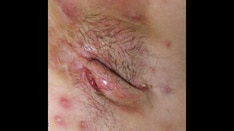The anti-inflammatory biologic drug anakinra can safely and effectively treat the skin disorder hidradenitis suppurativa (HS), according to a small randomized controlled, double-blind trial published online November 18 in JAMA Dermatology. Anakinra is a recombinant interleukin 1 (IL-1) receptor antagonist that blocks the biological activity of naturally occurring IL-1, a major mediator of the inflammatory response.
"Using the disease activity score and the newly proposed [Hidradenitis Suppurativa Clinical Response score], the results indicate that anakinra attenuates the severity of HS," write Vassiliki Tzanetakou, MD, from the Fourth Department of Internal Medicine at the University of Athens Medical School in Greece, and colleagues. "The Sartorius score was not helpful in demonstrating this clinical benefit, probably because it includes scoring for nondraining fistulas," they note.
Point prevalence of HS ranges from 1% to 4% globally, and treatment typically involves antibiotics, surgical excision, or anti-TNF therapy with etanercept, infliximab, or adalimumab, although not all patients respond to these interventions, the authors note.
"HS can be very debilitating if not controlled. Patients normally will suffer from chronic infections, draining abscesses in areas where there have skin folds, such as the axilla, groin, and buttocks," Tien Nguyen, MD, a dermatologist at Orange Coast Memorial Medical Center in Fountain Valley, California, told Medscape Medical News. Dr. Nguyen was not involved in the study. "For years, we did not have anything clinically effective or reliable to treat severe cases, and taking the surgical approach was never a good answer because we could not excise all these tunnels and tracts of infected sinuses under large areas of the skin."
The researchers randomly assigned 20 patients with Hurley stage I or II HS to receive either 100 mg anakinra or placebo by subcutaneous injection each day for 12 weeks, followed by a 12-week follow-up phase. The trial ran from March 2012 through February 2014.
The researchers used a per protocol analysis to assess outcomes using a disease activity score, the Sartorius score, and the Hidradenitis Suppurativa Clinical Response score. One participant in the anakinra group was lost to follow-up.
Two thirds (67%; six of nine) of the patients receiving anakinra had a decreased disease activity score at the end of treatment compared with 20% (two of 10) in the placebo group (P = .04). A positive Hidradenitis Suppurativa Clinical Response clinical response occurred in 78% (seven of nine) of those receiving anakinra and 30% of those receiving placebo at week 12 (P = .04). At week 24, 33% of the placebo patients and 10% of the anakinra patients had a positive Hidradenitis Suppurativa Clinical Response score.
Those receiving anakinra also experienced a significantly longer period of time before a new exacerbation of HS (log rank, 6.137; P = .01). The Sartorius score and patient-reported visual analog scores for pain and disease severity did not differ between the study groups, and neither group reported any serious adverse events.
The greatest differences in cytokine production by peripheral blood mononuclear cells "were found for [interferon]-&gamma, which was decreased in the anakinra arm, and for IL-22, which was increased in the anakinra arm," the researchers report. "Moreover, the production of [tumor necrosis factor] and of [interferon]-γ was increased during the follow-up period in the placebo arm but not in the anakinra arm."
The researchers acknowledge that it is currently unknown whether patients who do not respond to anti-tumor necrosis factor treatment would respond to anakinra, and which patients will benefit from any particular intervention.
"This is a small pilot study, but the difference in response of patients who received the drug compared to those who received placebo is promising," Delphine Lee, MD, PhD, dermatologist and director of the Carolyn Dirks and Brett Dougherty Laboratory for Cancer Research and Department of Translational Immunology at John Wayne Cancer Institute at Providence Saint John's Health Center in Santa Monica, California, told Medscape Medical News. "Larger studies and more work should be done to determine which patients might benefit from anakinra," said Dr Lee, who was not involved in the study.
The clinical trial was well designed and will likely lead to similar trials in the United States soon, with this drug or ones from the same class, Dr Nguyen told Medscape Medical News.
"This is the first concrete step toward having a more effective drug and better treatment option to treat these recalcitrant or severe cases," Dr Nguyen added. "Having another biologic agent as an alternative choice or that may be a better choice is a good idea for the patient as a consumer."
The research was funded by the Interleukin Foundation, the National Institutes of Health, the Hellenic Institute for the Study of Sepsis, and Swedish Orphan Biovitrum, which provided free syringes of anakinra for seven patients. One coauthor has received research funding from AbbVie SA, Swedish Orphan Biovitrum, and Sanofi Hellas and consulting fees and honoraria from AbbVie SA.
JAMA Dermatol. Published online November 28, 2015. Full text
Medscape Medical News © 2015 WebMD, LLC
Send comments and news tips to news@medscape.net.
Cite this: Anakinra Shows Promise in Hidradenitis Suppurativa - Medscape - Nov 23, 2015.










Comments